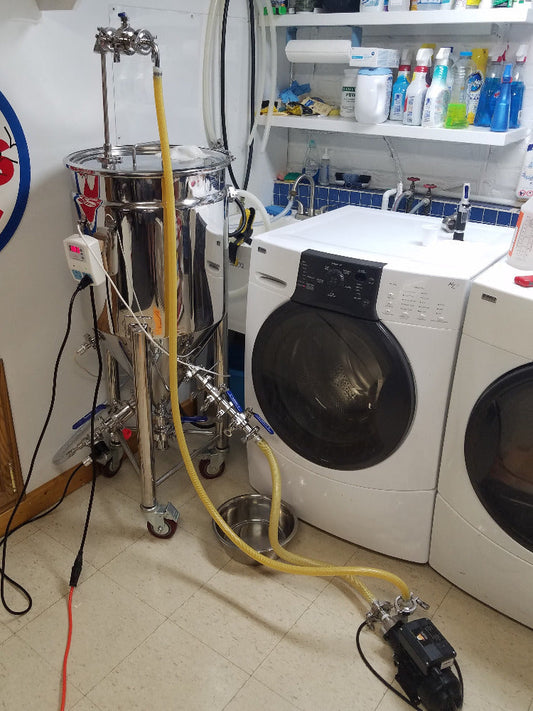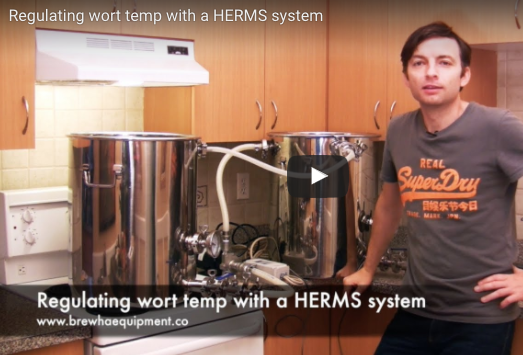Articles on brewing and opening a brewery

How to Avoid a Stuck Mash and Ruining the Heati...
Melting a heating element by dry-firing is not a pleasant experience, not to mention it could ruin a batch, so here are a few suggestions on how to avoid this...
How to Avoid a Stuck Mash and Ruining the Heati...
Melting a heating element by dry-firing is not a pleasant experience, not to mention it could ruin a batch, so here are a few suggestions on how to avoid this...

Mash tun dead space: benefit or liability
The BREWHA Mash Tun has been designed with increased space under the screen in order to include an element to provide precise temperature control for best mash efficiency and quality....
Mash tun dead space: benefit or liability
The BREWHA Mash Tun has been designed with increased space under the screen in order to include an element to provide precise temperature control for best mash efficiency and quality....

Operating the 240V/30amp Tabletop Brewing Power...
The 240V Brewing Power Controller (BPC) is designed to give safe and easy access to 240V/30amp power in the home. Without it, one would either have to use 120V power or...
Operating the 240V/30amp Tabletop Brewing Power...
The 240V Brewing Power Controller (BPC) is designed to give safe and easy access to 240V/30amp power in the home. Without it, one would either have to use 120V power or...

Using a Whirlpool Arm at Knockout
(This article was contributed by BREWHA customer Harold from Chicago, IL.) A great addition to the BIAC is a whirlpool arm, especially if you want to whirlpool your hops after knockout. It...
Using a Whirlpool Arm at Knockout
(This article was contributed by BREWHA customer Harold from Chicago, IL.) A great addition to the BIAC is a whirlpool arm, especially if you want to whirlpool your hops after knockout. It...

Improve mash efficiency with a recirculating pump
Precise control of temperature and water circulation in the grain bed will allow you to achieve a higher level of sugar conversion. Also includes an overview of the setup for...
Improve mash efficiency with a recirculating pump
Precise control of temperature and water circulation in the grain bed will allow you to achieve a higher level of sugar conversion. Also includes an overview of the setup for...

Controlling fermentation temperature
Regulating the temperature in your fermenter (3-in-1 or 4-in-1) is critical in order to obtain consistency from batch to batch and produce results that match the style of beer. If the...
Controlling fermentation temperature
Regulating the temperature in your fermenter (3-in-1 or 4-in-1) is critical in order to obtain consistency from batch to batch and produce results that match the style of beer. If the...

How to Build a Temperature-Controlled Closet or...
Precise temperature control during fermentation is a critical aspect of brewing high quality beer but it can be challenging to achieve, especially in warm climates where cold tap water is not available. BREWHA's...
How to Build a Temperature-Controlled Closet or...
Precise temperature control during fermentation is a critical aspect of brewing high quality beer but it can be challenging to achieve, especially in warm climates where cold tap water is not available. BREWHA's...

BREWHA Stainless HERMS Hot Liquor Tank
BREWHA Stainless Hot Liquor Tank is high quality hot liquor tank with stainless steel heat exchange coil inside, turns your sparge water reservoir into a safe and efficient heat exchange...
BREWHA Stainless HERMS Hot Liquor Tank
BREWHA Stainless Hot Liquor Tank is high quality hot liquor tank with stainless steel heat exchange coil inside, turns your sparge water reservoir into a safe and efficient heat exchange...

Regulating mash temperature with a Stainless HE...
In this video you'll learn how to produce sparge water for rinsing grain to improve mash efficiency. You'll also learn how to precisely and safely control your mash temperature with...
Regulating mash temperature with a Stainless HE...
In this video you'll learn how to produce sparge water for rinsing grain to improve mash efficiency. You'll also learn how to precisely and safely control your mash temperature with...

How to brew beer Step 3: Boiling and chilling wort
Learn how to boil, chill and ferment wort all in same vessel. This is the third video in a three part mini-series on learning how to brew beer using the...
How to brew beer Step 3: Boiling and chilling wort
Learn how to boil, chill and ferment wort all in same vessel. This is the third video in a three part mini-series on learning how to brew beer using the...

How to brew beer Step 2: Mashing grain to produ...
This is the second video of a three part mini series on learning how to brew beer. In this video you will learn how to increase or improve mash efficiency...
How to brew beer Step 2: Mashing grain to produ...
This is the second video of a three part mini series on learning how to brew beer. In this video you will learn how to increase or improve mash efficiency...

How to brew beer Step 1: Readying water and equ...
This is the first video in a three part series about how to setup BREWHA equipment (Stainless Homebrew Mash Tun, Stainless HERMS Hot Liquor Kettle and stainless conical fermenter) and...
How to brew beer Step 1: Readying water and equ...
This is the first video in a three part series about how to setup BREWHA equipment (Stainless Homebrew Mash Tun, Stainless HERMS Hot Liquor Kettle and stainless conical fermenter) and...

How to Build a sanitary LWD Heating Element
Attaching a heating element to a tri-clamp fitting and having it be leak-free is not difficult, but here are a few suggestions that might help you get it done right...
How to Build a sanitary LWD Heating Element
Attaching a heating element to a tri-clamp fitting and having it be leak-free is not difficult, but here are a few suggestions that might help you get it done right...

Does Brewing Your Own Beer Save You Money?
Is home brewing really worth it? That is a good question. What is the value of a hobby that brings you immense pleasure and satisfaction? High-end bicycles, ATVs, motorbikes, electronic...
Does Brewing Your Own Beer Save You Money?
Is home brewing really worth it? That is a good question. What is the value of a hobby that brings you immense pleasure and satisfaction? High-end bicycles, ATVs, motorbikes, electronic...

How to brew a Saison with the BREWHA BIAC
How to brew beer using the BREWHA BIAC method of brewing. Get superior quality and consistent results while saving time, space, and money. Simple, detailed instructions given on how to...
How to brew a Saison with the BREWHA BIAC
How to brew beer using the BREWHA BIAC method of brewing. Get superior quality and consistent results while saving time, space, and money. Simple, detailed instructions given on how to...
See next page for more articles on brewing equipment, how to brew beer and open a brewery